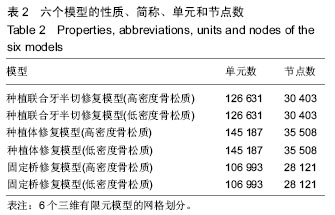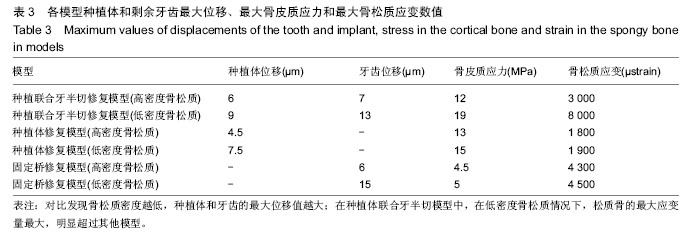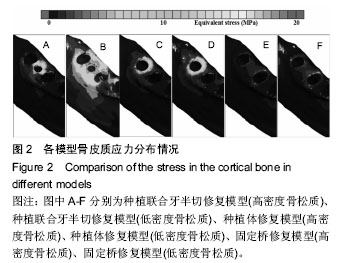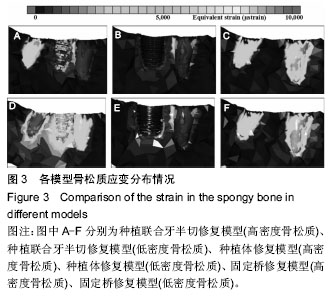| [1] 徐炳华,刘思逸,曹寅.下颌磨牙半切术后不同修复设计的临床效果[J].安徽医科大学学报,2009,21(4):531-532.
[2] Naveen YG,Patel JR,Parikh P,et al.Alternatives for restoration of a hemisected mandibular molar.BMJ Case Rep.2014;30(7):75.
[3] Pjetursson BE,Tan K,Lang NP,et al.A systematic review of the survival and complication rates of fixed partial dentures (FPDs) after an observation period of at least 5 years.Clin Oral Implants Res. 2004;15(6):625-642.
[4] 安倩.牙半切术的临床应用[J].口腔医学研究, 2013, 29(10): 984-986.
[5] Shigemitsu R,Yoda N,Ogawa T,et al. Biological-data- based finite-element stress analysis of mandibular bone with implant-supported overdenture.Comput Biol Med.2014; 54(6):44-52.
[6] Desai SR,Karthikeyan I,Singh R.Evaluation of micromovements and stresses around single wide-diameter and double implants for replacing mandibular molar: a three-dimensional FEA.ISRN Dent.2012;7(4):1-10.
[7] Toniollo MB,Macedo AP,Pupim D,et al. Three-Dimensional Finite Element Analysis Surface Stress Distribution on Regular and Short Morse Taper Implants Generated by Splinted and Nonsplinted Prostheses in the Rehabilitation of Various Bony Ridges. J Craniofac Surg.2016;27(3):e276-280.
[8] 李景辉,陈光宇,张方明.种植体联合牙半切术单冠修复下颌磨牙的疗效观察[J].北京口腔医学, 2012,20(6):334-337.
[9] Hasan I,Röger B,Heinemann F,et al.Influence of abutment design on the success of immediately loaded dental implants: Experimental and numerical studies. Med Eng Phys. 2012;34(7):817-825.
[10] Chang HS,Chen YC,Hsieh YD,et al.Stress distribution of two commercial dental implant systems: A three-dimensional finite element analysis.J Dent Sci. 2013; 8(2):261-271.
[11] Marcián P,Borák L,Valášek J,et al.Finite element analysis of dental implant loading on atrophic and non-atrophic cancellous and cortical mandibular bone - a feasibility study.J Biomech.2014;47(16):3830-3836.
[12] Bouazza-Juanes K,Martínez-González A,Peiró G,et al. Effect of platform switching on the peri-implant bone: A finite element study.J Clin Exp Dent 2015;7(4):e483-488.
[13] Balkaya MC.Investigation of influence of different implant size and placement on stress distribution with 3-dimensional finite element analysis.Implant Dent. 2014; 23(6):716-722.
[14] 丁存善,王荃,徐小红.磨牙半切除术后与邻牙联冠修复的临床疗效[J].口腔医学,2015,35(5):386-388.
[15] 陈虹,徒珂欣,田卓,等.牙半切除术联合固定修复保留患牙36例[J].实用医学杂志,2016,32(4):685-686
[16] Pratheep KV,Abraham A,Annapoorni H,et al. Comparative evaluation of stresses in tooth implant connected fixed partial denture by varying the implant design and position: a 3D finite element study.Indian J Dent Res.2013;24(4):439-445.
[17] de Paula GA,da Mota AS,Moreira AN,et al.The effect of prosthesis length and implant diameter on the stress distribution in tooth-implant-supported prostheses: a finite element analysis. Int J Oral Maxillofac Implants. 2012;27(3):19-28.
[18] Muddugangadhar BC,Amarnath GS,Sonika R,et al. Meta- analysis of failure and survival rate of implant-supported single crowns fixed partial denture, and implant tooth-supported prostheses.J Int Oral Health.2015;9(7):7-11.
[19] Lanza MD,Seraidarian PI,Jansen WC,et al.Stress analysis of a fixed implant-supported denture by the finite element method (FEM) when varying the number of teeth used as abutments.J Appl Oral Sci. 2011; 19(6):655-661.
[20] Heinemann F,Hasan I,Bourauel C,et al.Bone stability around dental implants: Treatment related factors.Ann Anat.2015;199(5):3-8.
[21] Premnath K,Sridevi J,Kalavathy N,et al.Evaluation of stress distribution in bone of different densities using different implant designs: a three-dimensional finite element analysis. J Indian Prosthodont Soc. 2013; 13(4):555-559. |
.jpg)




.jpg)
.jpg)
.jpg)